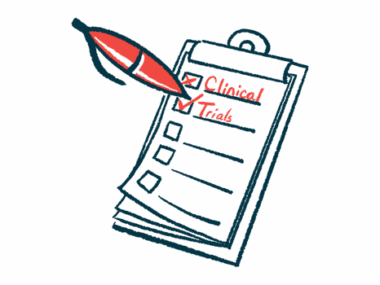Understanding Ataxia Helps Me Endure My Angel’s Struggle With Stairs
Written by |

Ataxia is one of those words that sounds scary before you even know what it is. It’s one of the culprits that affect the coordination, balance, and walking of my 12-year-old Angel, Juliana.
A neurological disorder that affects the nervous system, ataxia can cause a person to lose muscle control or make it hard to coordinate voluntary movements. For those living with Angelman syndrome, understanding ataxia is important.
Ataxia affects more than 95% of those with Angelman syndrome. Angels have stiff joints that make it challenging for them to walk. Angels may also have a wide gait that makes walking more cumbersome.
What goes up
Juliana has been walking since she was about 4. We felt certain she would walk eventually. Patience and reading stories of other Angels walking encouraged me while we waited for Juliana’s big moment. Although Juliana walks quite well, she still struggles to make transitions to different surfaces.
Now we have a new obstacle with stairs. For a while, Juliana has been pushing back on walking downstairs. She’ll go up quickly and without a fuss, but coming down is a different story. There was no particular event that seemed to trigger this. Even a trip to the orthopedist revealed nothing. It’s one of those things that is simply going to take time. Like the reflux that plagued her when she was younger, I know this malady will eventually become a thing of the past.
Sometimes when she’s not feeling well I’ll let her stay upstairs. But there are no super-flying powers to get out of the house. The stairs must be conquered. While my husband and I do our best to limit her trips up and down the stairs, it is necessary at least once each day.
After reading more about ataxia, I knew it was time to simply give Juliana a little more grace. She’s doing her best, and something — whether physical or mental — is turning a trip downstairs into a nightmare for her. Instead of spending more time on the why, I’ve decided to focus on a better strategy: I’m trying new prompts to coax her down the stairs.
‘It’s gonna be a long, long time’
We start at the banister. I pause as she gets her bearing. I noticed that she never wants to come down right away. Instead, she peers over the edge to get a view of her challenge. I try to focus her attention away from what’s coming. “One, two, three,” I say. As I count down, I give Juliana’s left leg a nudge from behind. It’s a physical prompt that says it’s time to move.
“Step, step, step,” I repeat until we get to the landing. We continue on until we reach the bottom. When she finally hits the floor, I shower her with praise. After my accolades, she beams with pride. Since starting the prompts, I have noticed a big difference in Juliana’s willingness to come downstairs with less fussing.
We have a landing in between two sets of stairs. She has a walking break in between the two sets. In the past, she would stop there and scream before going to the next set of stairs. With my new prompts, she’s grabbing the stair rail before I even start talking to her.
I can’t begin to imagine what things feel like inside Juliana’s body. Something in her is flashing a warning when it’s time to head downstairs. There is comfort in realizing that Juliana has enough awareness to try to protect herself, but it’s taking the patience of Job to slowly walk and coax her down each day.
What takes only about seven minutes feels like hours. Juliana proceeds with caution and prompting. But it really is a great safety measure. Seeing it from this perspective helps a lot. After all, we waited four years for her to walk. Now, we’ll wait again as she regains her confidence to come downstairs.
Note: Angelman Syndrome News is strictly a news and information website about the disease. It does not provide medical advice, diagnosis, or treatment. This content is not intended to be a substitute for professional medical advice, diagnosis, or treatment. Always seek the advice of your physician or other qualified health provider with any questions you may have regarding a medical condition. Never disregard professional medical advice or delay in seeking it because of something you have read on this website. The opinions expressed in this column are not those of Angelman Syndrome News or its parent company, Bionews, and are intended to spark discussion about issues pertaining to Angelman syndrome.







Leave a comment
Fill in the required fields to post. Your email address will not be published.